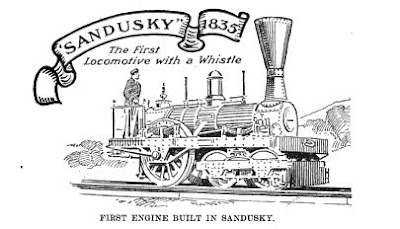Samuel J. Catherman was born in Union City, Pennsylvania, on July 29, 1817. He came to Sandusky as a boy, and learned the carpenter trade. He moved back to Pennsylvania for a time, and in 1835 settled permanently in Sandusky, along with his mother, and two siblings. At that time, Catherman found work at the Mad River Railroad’s shops in Sandusky. He helped assemble the locomotive “Sandusky”, under the direction of Thomas Hogg, and he recalls watching it make it first trip from Sandusky to Bellevue.
Eventually Samuel J. Catherman became a master mechanic with the railroad. An article which appeared in the May 20, 1911 issue of the Sandusky Register reported that Catherman was the designer and builder of the first end-door passenger railroad coach with reversible seats.
Before undertaking his own contracting business, Catherman was in a partnership with Laurence Cable. One of their contracts was to build 2,000 reapers known as “The Hero,” which had been invented by a Mr. Henderson. After Laurence Cable and Samuel Catherman undertook a project in which they modernized a portion of Washington Street, the work that they did needed no repairs for nearly forty years.
As a contractor, Samuel J. Catherman built over twenty lime kilns and several residences. After building the cribbing for the Mad River Railroad, in the east and west ends of the Sandusky Bay, Catherman received the contract for the construction of the railroad bridge across Sandusky Bay. He employed 300 men during this project. We read in the History of the Western Reserve, by Harriet Taylor Upton, that the building of the Bay Bridge “gained for him the reputation of performing the fastest work of its kind ever accomplished.” The May 30, 1854 issue of the Sandusky Daily Commercial Register reported that once the railroad bridge was completed across Sandusky Bay, there would be continuous rail service from Sandusky to Chicago, a total of 271 miles. (The railroad bridge across Sandusky Bay was built several years before the Sandusky Bay Bridge, which was designed for automobile traffic, made its debut in 1929.) More details about the history of steam railroads in Erie County are found in an article by Paul F. Laning in the Twin Anniversary Edition of the Sandusky Register and Star News, from November 24, 1947. A bound copy of this special edition newspaper is housed at the Sandusky Library Archives Research Center.
In 1844 Samuel J. Catherman married Clarissa Gregg, the daughter of Mr. and Mrs. Benjamin Gregg. They had six children, but only four who survived to adulthood. One of the Catherman children, Georgia Catherman, taught first graders in Sandusky for thirty-five years. Samuel J. Catherman died in Sandusky on May 19, 1911. He is buried at Sandusky’s Oakland Cemetery next to his wife, who had passed away in 1907.
Subscribe to:
Post Comments (Atom)

 this blog
this blog







No comments:
Post a Comment